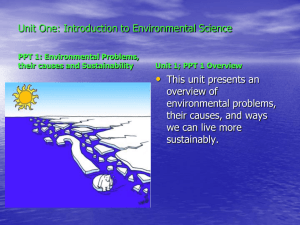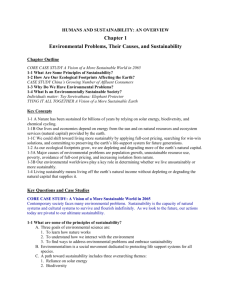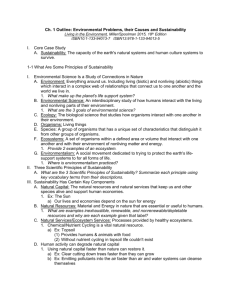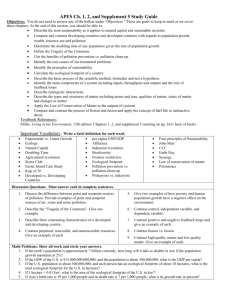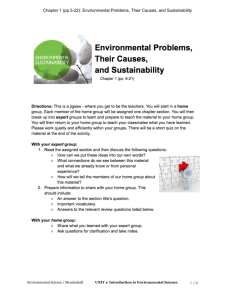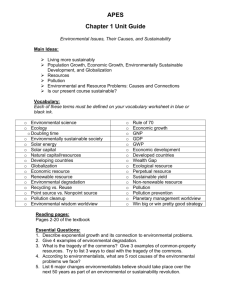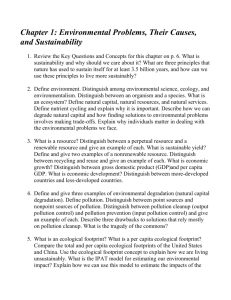APES CH1 Overview
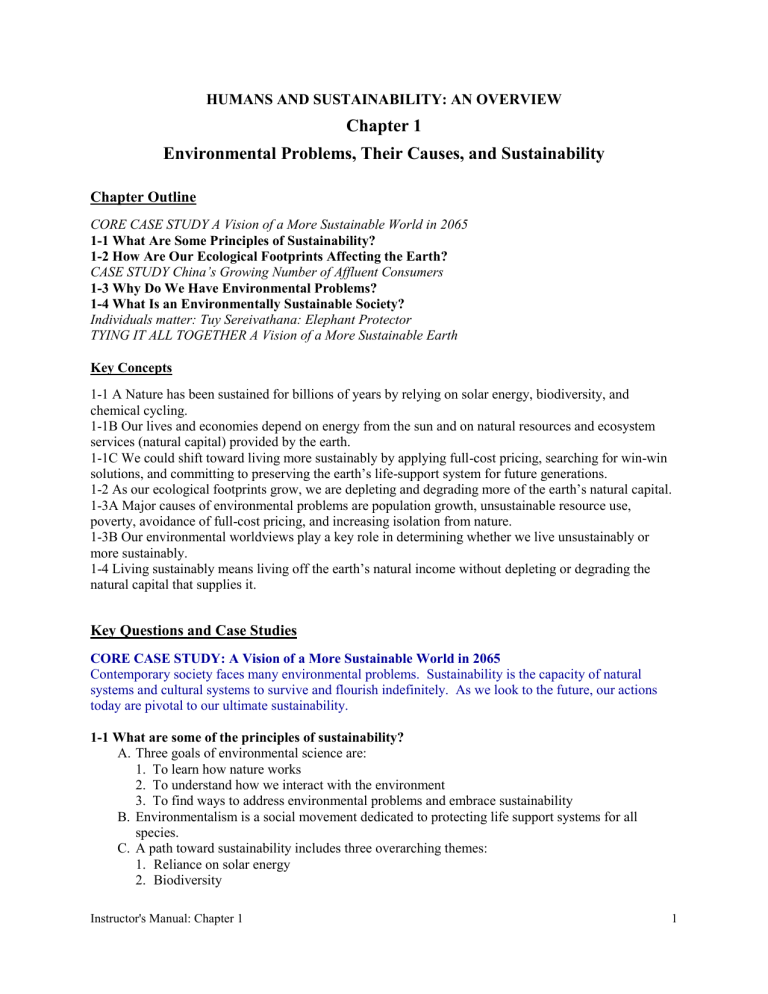
HUMANS AND SUSTAINABILITY: AN OVERVIEW
Chapter 1
Environmental Problems, Their Causes, and Sustainability
Chapter Outline
CORE CASE STUDY A Vision of a More Sustainable World in 2065
1-1 What Are Some Principles of Sustainability?
1-2 How Are Our Ecological Footprints Affecting the Earth?
CASE STUDY China’s Growing Number of Affluent Consumers
1-3 Why Do We Have Environmental Problems?
1-4 What Is an Environmentally Sustainable Society?
Individuals matter: Tuy Sereivathana: Elephant Protector
TYING IT ALL TOGETHER A Vision of a More Sustainable Earth
Key Concepts
1-1 A Nature has been sustained for billions of years by relying on solar energy, biodiversity, and chemical cycling.
1-1B Our lives and economies depend on energy from the sun and on natural resources and ecosystem services (natural capital) provided by the earth.
1-1C We could shift toward living more sustainably by applying full-cost pricing, searching for win-win solutions, and committing to preserving the earth’s life-support system for future generations.
1-2 As our ecological footprints grow, we are depleting and degrading more of the earth’s natural capital.
1-3A Major causes of environmental problems are population growth, unsustainable resource use, poverty, avoidance of full-cost pricing, and increasing isolation from nature.
1-3B Our environmental worldviews play a key role in determining whether we live unsustainably or more sustainably.
1-4 Living sustainably means living off the earth’s natural income without depleting or degrading the natural capital that supplies it.
Key Questions and Case Studies
CORE CASE STUDY: A Vision of a More Sustainable World in 2065
Contemporary society faces many environmental problems. Sustainability is the capacity of natural systems and cultural systems to survive and flourish indefinitely. As we look to the future, our actions today are pivotal to our ultimate sustainability.
1-1 What are some of the principles of sustainability?
A.
Three goals of environmental science are:
1.
To learn how nature works
2.
To understand how we interact with the environment
3.
To find ways to address environmental problems and embrace sustainability
B.
Environmentalism is a social movement dedicated to protecting life support systems for all species.
C.
A path toward sustainability includes three overarching themes:
1.
Reliance on solar energy
2.
Biodiversity
Instructor's Manual: Chapter 1 1
3.
Chemical or nutrient cycling
D.
Resources can be taken from the environment to meet our needs or wants.
1.
Perpetual resources are continuously available (sunlight).
2.
Renewable resources can be replenished in the foreseeable future (forests, fertile topsoil).
3.
Non-renewable resources are found in fixed quantities and are not renewable on a human time scale.
E.
Economic growth is an increase in a nation’s output of goods and services, measured by gross domestic product (GDP).
1-2 How are our ecological footprints affecting the earth?
A. The process of depleting resources is known as environmental degradation or natural capital degradation.
B. Pollution is any presence in the environment that is harmful to health or survival or humans or other organisms.
1. Biodegradable pollutants break down over time and nonbiodegradable pollutants cannot break down.
2. Pollutants can have three kinds of effects: a.
They disrupt or degrade life-support systems for humans or other species. b.
They damage wildlife, human health, or property. c.
They create nuisances.
3.
There are two ways to deal with pollution: a.
Pollution cleanup b.
Pollution prevention
C. The Tragedy of the Commons describes the overuse or degradation of freely available resources.
The cumulative effect of many users exploiting a common resource can degrade it such that no one can benefit from it.
D. Ecological footprint
1. The amount of biologically productive land and water needed to supply renewable resources and absorb waste for people in a given area.
2. Humanity’s ecological footprint exceeds by at least 30% the earth’s biological capacity to support life.
E. IPAT summarizes environmental impact
1. Impact (I) = Population (P) x Affluence (A) x Technology (T).
CASE STUDY: China’s Growing Number of Affluent Consumers
The number of affluent consumers is rising rapidly, as people in underdeveloped countries attain a middleclass lifestyle. China is already a leading consumer of many resources, and its economy and population are continuing to grow at a rapid rate. Thus, its ecological footprint and overall level of resource consumption are expected to continue to grow.
F. The ecological tipping point refers to an irreversible shift in the behavior of a natural system. We currently face three potential tipping points:
1. The collapse of fish populations from overfishing
2. Species extinction from overharvesting and habitat destruction.
3. Climate change from burning coal and oil
G. Culture describes a society’s knowledge, beliefs, technology and practices
1. Three major cultural changes have occurred in human history a.
Agricultural revolution b.
Industrial-medical revolution c.
Information-globalization revolution d.
And now a fourth, called the sustainability revolution
1-3 Why do we have environmental problems?
Instructor's Manual: Chapter 1 2
A. Four major causes of environmental problems are:
1. Population growth
2. Wasteful resource use
3. Poverty
4. Poor environmental accounting
B. Exponential growth occurs when a population increases by a fixed percentage per unit of time.
C.
Affluence results in high levels of consumption.
1. Affluence can lead to an unsustainable addiction to acquiring material things.
2. Affluence can lead to better education, improved health, and more resources to address environmental issues.
D. Poverty occurs when people are unable to fulfill their basic needs.
1. Poverty conditions in heavily populated areas can have significant environmental impacts.
2. Pollution and environmental degradation can have severe impacts on the poor. Three significant health issues are: a. Malnutrition
1-4 What is an environmentally sustainable society?
A.
An environmentally sustainable society meets the current and future basic resource needs of its people in a just and equitable manner by protecting natural capital and living off its income.
1. The shift to sustainability involves building social capital, which involves bringing together people with different views and values and finding common ground.
B.
Individuals matter
1. It takes only 5-10% of a community to bring about major social change.
2. Significant social change can occur very rapidly. b. Inadequate sanitation and access to safe drinking water c. Respiratory disease
E. Environmental worldviews and ethics determine the way people view the seriousness of environmental problems.
1.
The planetary management worldview holds that nature exists to meet our needs.
2.
The stewardship worldview holds that we manage the earth, but that we also have an ethical responsibility to be stewards of the earth.
3.
The environmental worldview holds that we are connected to nature and that nature exists for all species equally.
Teaching Tips
Large Lecture Courses:
What are the greatest environmental problems facing the world today? List student responses on the board, and ask them to suggest what the consequences of these problems might be for them and their families. Then perform the same brainstorming activity by focusing on the local region only. Ask the students to suggest reasons for any discrepancies between the two lists, such as local industries or activities. Use this exercise as an opportunity to highlight the main themes that will be touched on during the rest of the course and textbook, and to show the students the ways in which environmental issues permeate their own lives.
Instructor's Manual: Chapter 1 3
Small Lecture Courses:
Ask students to get in small groups of three to six students each. Have each group rank what they perceive to be the three greatest environmental crises facing their generation. For each, they should list the reasons why that issue is so important. Then, have the groups place their original list on the board, and facilitate a debate between groups over which issue is most pressing and why. Use this exercise to illustrate the complexity of environmental issues, insofar as the public is generally not in agreement as to cause, severity, or potential solutions.
Key Terms
biodiversity biodegradable pollutants culture developed countries developing countries ecological footprint ecological tipping point ecology economic development economic growth environment environmental degradation environmental ethics environmental science environmental wisdom worldview environmental worldview environmentalism environmentally sustainable society exponential growth gross domestic product
(GDP) input pollution control less-developed countries more-developed countries natural capital natural income natural resources natural services nondegradable pollutants nonpoint sources nonrenewable resources nutrient cycling organisms output pollution control per capita ecological footprint per capita GDP perpetual resource planetary management worldview point sources pollution pollution cleanup pollution prevention poverty recycling renewable resource resource reuse social capital species stewardship worldview sustainability sustainable yield
Term Paper Research Topics
1 . Population: UN population projections.
2. Poverty: definition, roots, worldwide distribution, changing the current situation.
3. Technology: research, development, and distribution of new technologies in the United States.
4. State of the world: bibliography of current resources summarizing the state of the world and the most important areas of concern.
5. Pollution and environmental degradation: one form of pollution or environmental degradation, and its existence in different countries or choose one incident as a case study.
Instructor's Manual: Chapter 1 4
6. Computer modeling methods: Limits to Growth by Meadows and Meadows; today's global climate models.
7. National: national efforts to address environmental needs; Blueprint for the Environment.
8. Global: global attempts to address the environment and the economy; the UN document Our
Common Future .
Environmental Issues, Their Causes, and Sustainability
